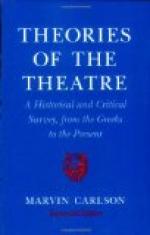The few points which we have briefly touched upon are usually explained, by academic critics, on literary grounds; but it is surely more sane to explain them on grounds of common sense, in the light of what we know of the conditions of the Attic stage. Similarly, it would be easy to show how Terence and Calderon, Shakespeare and Moliere, adapted the form of their plays to the form of their theatres; but enough has already been said to indicate the principle which underlies this particular phase of the theory of the theatre. The successive changes in the physical aspect of the English theatre during the last three centuries have all tended toward greater naturalness, intimacy, and subtlety, in the drama itself and in the physical aids to its presentment. This progress, with its constant illustration of the interdependence of the drama and the stage, may most conveniently be studied in historical review; and to such a review we shall devote a special chapter, entitled Stage Conventions in Modern Times.
We may now observe that, in the third place, the essential nature of the drama is affected greatly by the fact that it is destined to be set before an audience. The dramatist must appeal at once to a heterogeneous multitude of people; and the full effect of this condition will be investigated in a special chapter on The Psychology of Theatre Audiences. In an important sense, the audience is a party to the play, and collaborates with the actors in the presentation. This fact, which remains often unappreciated by academic critics, is familiar to everyone who has had any practical association with the theatre. It is almost never possible, even for trained dramatic critics, to tell from a final dress-rehearsal in an empty house which scenes of a new play are fully effective and which are not; and the reason why, in America, new plays are tried out on the road is not so much to give the actors practice in their parts, as to determine, from the effect of the piece upon provincial audiences, whether it is worthy of a metropolitan presentation. The point is, as we shall notice in the next chapter, that since a play is devised for a crowd it cannot finally be judged by individuals.
The dependence of the dramatist upon his audience may be illustrated by the history of many important plays, which, though effective in their own age, have become ineffective for later generations, solely because they were founded on certain general principles of conduct in which the world has subsequently ceased to believe. From the point of view of its own period, The Maid’s Tragedy of Beaumont and Fletcher is undoubtedly one of the very greatest of Elizabethan plays; but it would be ineffective in the modern theatre, because it presupposes a principle which a contemporary audience would not accept. It was devised for an audience of aristocrats in the reign of James I, and the dramatic struggle is founded upon the doctrine of the divine right of kings. Amintor, in the play, has suffered a profound personal injury at the hands of his sovereign; but he cannot avenge this individual disgrace, because he is a subject of the royal malefactor. The crisis and turning-point of the entire drama is a scene in which Amintor, with the king at his mercy, lowers his sword with the words:—




